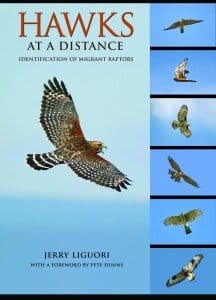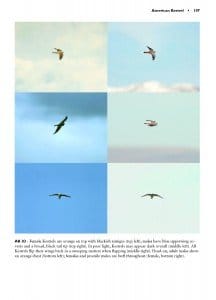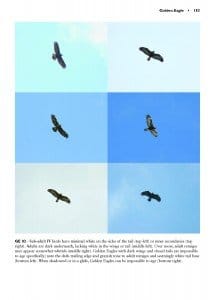 I confess, I don’t always love hawks. Sure, they’re beautiful and powerful, a reminder of the feral freedom of the skies. They’re also confoundingly difficult to identify, the eternal inscrutable spot in the distance. This is probably why I number so many hawk books in my collection.
I confess, I don’t always love hawks. Sure, they’re beautiful and powerful, a reminder of the feral freedom of the skies. They’re also confoundingly difficult to identify, the eternal inscrutable spot in the distance. This is probably why I number so many hawk books in my collection.
There’s the slim Hawk Watch: At Guide for Beginners, bought on my first visit to the Cape May hawk watch, the classic A Field Guide to North American Hawks, part of the Peterson Field Guide series, the handy Hawks & Owls of the Great Lakes Region & Eastern North America, with its photographic comparison charts. (For some reason, I never bought the classic Hawks in Flight, by Pete Dunne, David Sibly, and Clay Sutton.) And, there are the non-field guide hawk books, the narratives that read like love songs to raptors and the huge coffee table books, gifts from non-birding friends.
So, looking a Jerry Liguori’s newest publication, Hawks At A Distance: Identification of Migrant Raptors (Princeton University Press, 2011), I ask myself, “Why? Why another hawk book?”
Liguori wrote Hawks At A Distance to fill a gap in raptor identification literature; he wanted to show birders how to identify distance hawks in flight, in migration, in the field, using photographs taken in “real life” settings. He is well qualified to write such a book. Liguori has conducted raptor migration counts at major U.S. hawk 
watch sites, and has written articles on hawk identification for the American Birding Association and the Utah Birders blog. He is the THE go-to person for hawk identification. He is also the author of my current favorite hawk book, Hawks From Every Angle: How To Identify Raptors In Flight (PUP, 2005).
At the heart of Hawks At A Distance are 558 color photographs, most arranged as color plate composites comparing different versions of the same bird. Here is one of the three plates for American Kestrel.
There are photographs of buteos soaring overhead and harriers gliding low, of eagles coming at you head-on and flying away with only the tail in focus, of falcons backlit and kites in shadows. I was a little overwhelmed when I first opened the book, till I realized that each photograph has a purpose, illustrating the different forms or colors a raptor can take in the air. The number of plates per species varies, which makes a lot of sense. There are 2 plates for Turkey Vulture and 13 plates for Red-tailed Hawk.
Like The Crossley ID Guide, the photographs work best when used with the text. Liguori give a succinct “Overview” and “Plumage” description for each group (accipitor, buteo, etc.) and each species, delineating flight patterns, flight shapes, and all plumage variations (and if you thought you knew them all, you might be surprised.)
The most important identifying characteristics are in bold print, a feature I find enormously helpful. So, I learn that kestrels appear “dainty, slim overall, and lively and nimble in flight” but “can appear dark underneath on overcast days.” All the little clues that hawk watchers have accumulated over the years, all the details necessary to distinguish a kestrel from a Merlin, a Sharpie from a Cooper’s, are in the volume. Twenty-nine raptor species are covered (no owls): twenty commong migrant hawks and nine additional “Uncommon Migrants and Others.”
The photographic plates and commentary take raptor identification to a  level of extremely fine detail that may be unprecedented. In Golden Eagle plate 03 (left) we learn that “over snow, adult remiges may appear somewhat whitish (middle right)” and that “when shadowed or in a glide, Golden Eagles can be impossible to age (bottom left)”. This can be intimidating to birders like me, who are hawk identification challenged. But, the beauty of Hawks At A Distance is that you can drill down through the different levels of text, taking in as much detail as you can handle at your level.
level of extremely fine detail that may be unprecedented. In Golden Eagle plate 03 (left) we learn that “over snow, adult remiges may appear somewhat whitish (middle right)” and that “when shadowed or in a glide, Golden Eagles can be impossible to age (bottom left)”. This can be intimidating to birders like me, who are hawk identification challenged. But, the beauty of Hawks At A Distance is that you can drill down through the different levels of text, taking in as much detail as you can handle at your level.
I recommend reading the “Introduction”, which defines terms like “remiges” (“secondaries and primaries”), and the last chapter, “Shapes”, in which multitudinous silhouettes (30-52) are presented for each of the 20 major species. I am a big silhouette fan. They help me focus on structure and not get distracted by plumage which, I now know, can differ depending on sex, age, light, weather, and angle.
All in all, this is an excellent, compact guide that nicely complements Hawks From Every Angle. Put the two books together and you get the raptor identification guide of every hawk watchers’ dreams. The only criticism I have is that I want more! I want more on Short-tailed Hawk, one of the uncommon migrants given briefer treatment. I want companion videos, showing the flight patterns in action. I want Jerry Liguori to come east and do a hawk watch with me.
Both books are published by Princeton University Press, which means the binding and paper are of high, sturdy quality, and that the color photographs are well printed. (Many of the full-page photographs are lovely in their own right, not just as teaching tools.) Both books are priced very reasonably in paperback format (see below).
I still don’t always love hawks. But, I am quite fond of both Liguori guides, and dream of the time I can look at that speck in the sky and say, “Large accipiter, powerful flight, stiff wingbeats–Northern Goshawk!”
I’m curious about your experiences with these guides or other hawk books (or apps) in the field. Which guide worked best for you? Which book do you keep in your car during hawk migration season? And, in a perfect raptor world, which hawk guide author would you choose to spend an afternoon hawk watching with?
Hawks at a Distance: Identification of Migrant Raptors, by Jerry Liguori, with a foreword by Pete Dunne. Princeton University Press, 2011. 216 pp.Paper, $19.95, ISBN: 9780691135595; Cloth, $49.50, ISBN: 9780691135588. Also availabe as an e-book, $19.95, 9781400838264.













Thank you so much for sharing this I have been looking for a good guide like this
Thanks for the great review. Except for when very obvious, I always find myself “hawk id-ing” challenged. I look forward to acquiring a copy of this book and maybe will finally be able to identify those dots in the sky.
Definitely agree with the review, an excellent resource!
I got the chance to watch hawks with Liguori years ago at the Goshute Mountains and he was just amazing. He was identifying “specks”. He was describing birds just like in “Hawks at a Distance”, a few adjectives summarizing the bird depending on what the bird was doing. He was generous with his knowledge and it was obvious (even infectious) that he enjoyed talking about hawks. I have been to many hawk migration sites, but I wouldn’t hesitate as to which author I would spend an afternoon with and hope to again one day.
Great review! I’ve never done a proper hawk watch, and haven’t really had a chance to use this in the field. But I’d say that Liguori’s two books are the definitive treatment of hawks in flight right now. I also really like the two Wheeler guides, especially since they include perched birds and raptors that are unlikely to be seen at hawk-watch sites that Liguori doesn’t include.
Oh, Hawks in Flight is still worth getting, if only for Dunne’s writing.
I’m looking forward to many more of your reviews.
Donna:
I was forwarded your review — Thank you, it was so nice to read and to see that you and others enjoy my books!
I hope to get back East one day. For anyone interested, I lead hawk ID workshops here in Utah in spring and fall, and will be doing a weekend workshop at the Goshutes next fall. They will be publicized on HWI’s website when the time comes. I love teaching and spending time with people eager to learn. And I am still learning. So, the interest expressed here in watching with me is a great compliment.
Happy Hawk watching,
Jerry Liguori
Susan – Let me know how you like the book after you use it for a while. I think it’s good to have long-term feedback on field guides.
Jean L. – Thanks! I know you happen to be quite adept at id-ing those Sharpies and Red-shouldered Hawks in Forest Park. A little closer than dots, but sometimes a challenge with all those trees.
Derek – Hawkwatching with Jerry Liguori! Sounds like everything I fantasized about. Thank you for the brief portrait of a hawk expert in action.
Grant – Yes, Brian Wheeler’s books are excellent. I’m looking at A Photographic Guide to North American Raptors, by Brian K. Wheeler & William S. Clark(PUP, 2003) as I type, and lusting after the adult White-tailed Hawk. I could have written so much more on all the hawk books out there! And, yes, I do have to buy Dunne’s book.
Once in New Jersey I thought I saw a good hawk but it turned out to be a 727 headed to Newark. It was really far away.
Can you upload the Sharp Shinned vs. Coopers page?
Hi Jerry! I’m so happy you read and enjoyed the review. (Even a little giddy.) You now have me thinking about going west for hawk watching. I looked up photos of the Goshute Mountains and they look unbelievably beautiful. I’ll keep an eye on the Hawkwatch International website, http://www.hawkwatch.org/, for updates on your sessions.
Christina – The photos above are posted courtesy of Princeton University Press (thank you!). Any home-grown photo of the book’s plate would not be very clear. But, there are alternatives! Mike wrote a great 10,000 Birds post in 2007 on the Cooper’s vs. Sharpie identification conundrum, http://10000birds.com/cooper-v-sharpie.htm/
Congrats on the plane id!
Donna – Hawk watching out West is definitely fun.